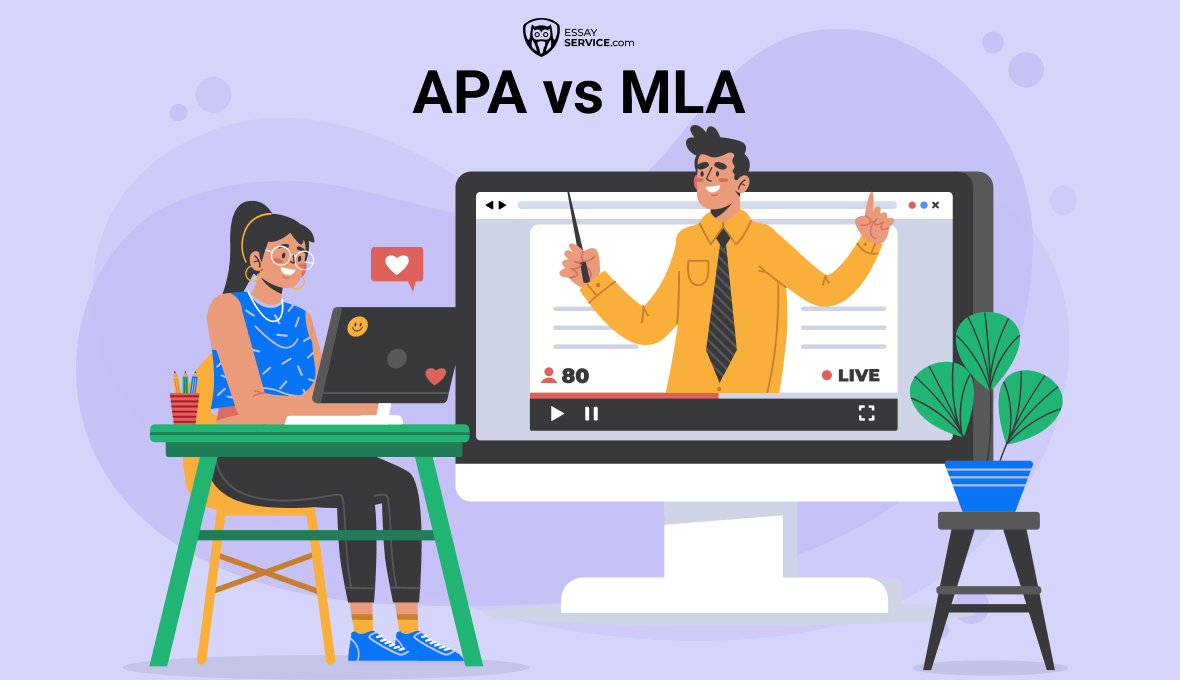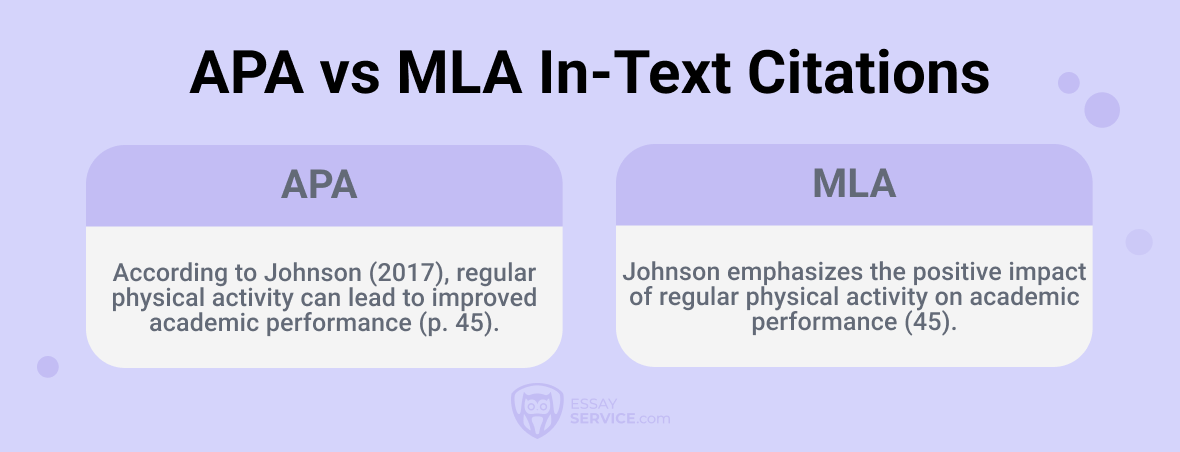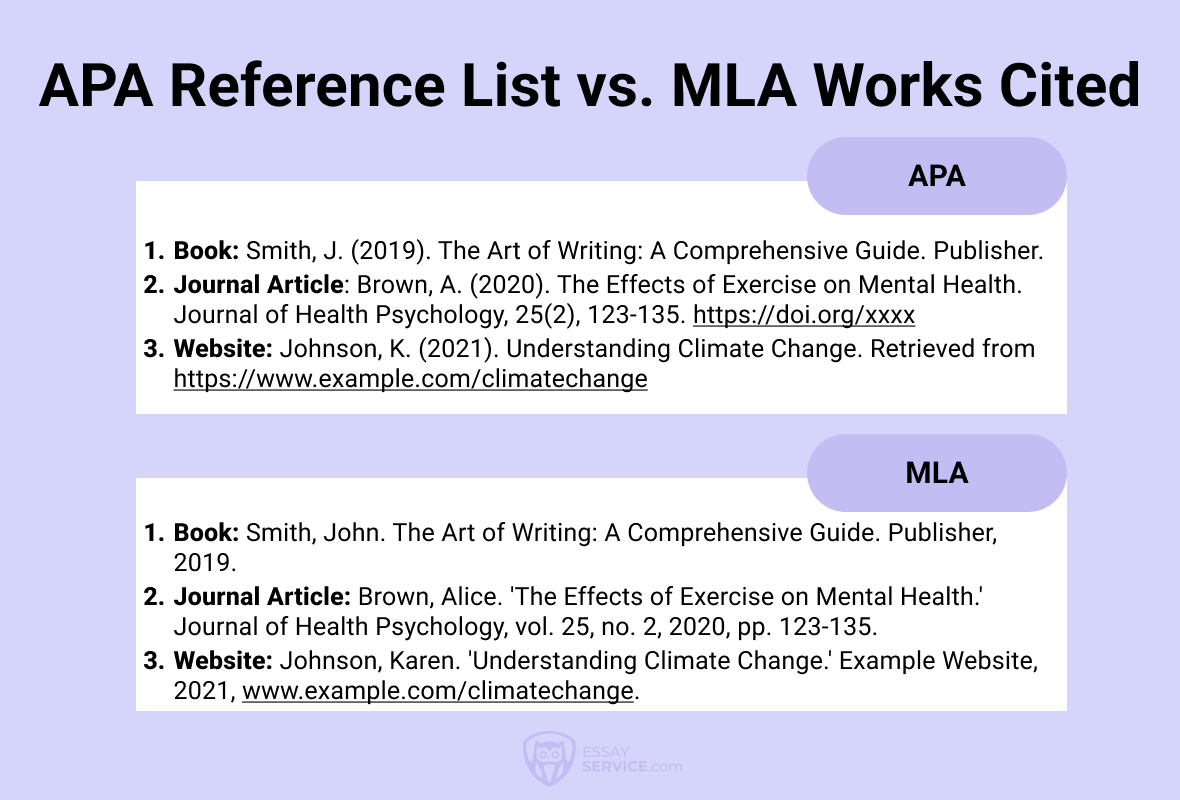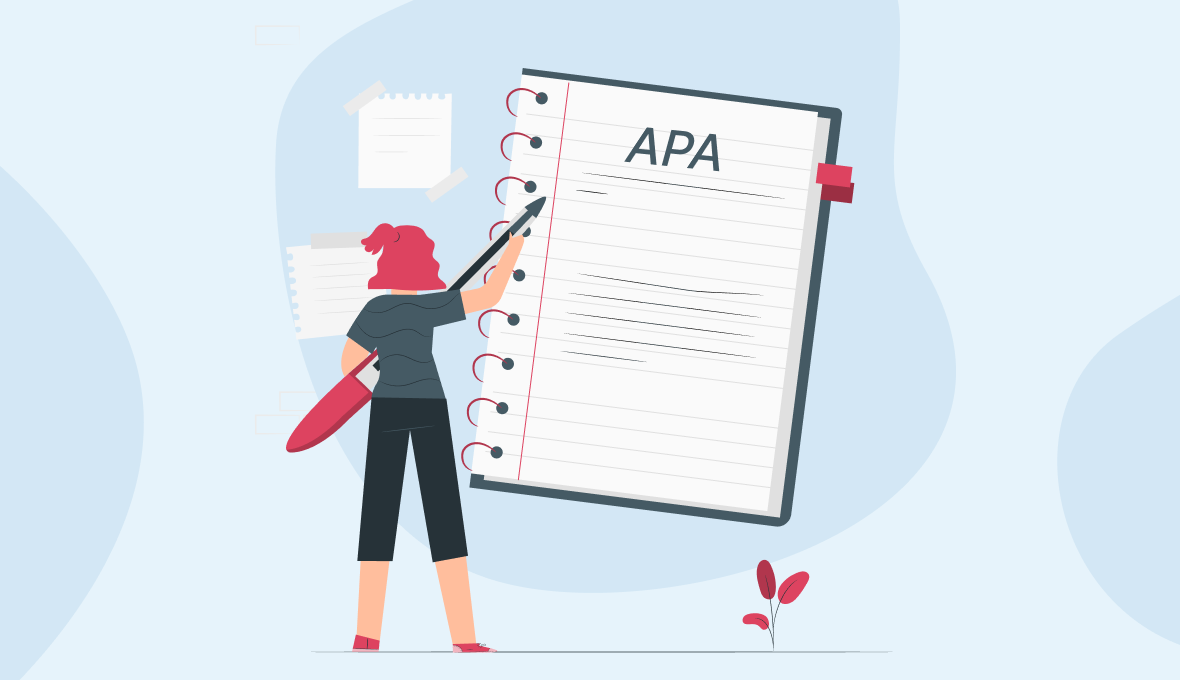
APA vs MLA: Definition, Formatting, Examples and More!
APA and MLA are among the most widely used citation styles in academic writing. Both citations consist of a brief parenthetical citation in the text and a full reference at the end of the paper. However, the formatting and rules for elements like title capitalization, author names, and date placement differ between the styles.
Furthermore, layout and formatting vary between these two. To ensure correct APA vs MLA formatting, let's check out the article prepared by our APA paper writing service.
What is APA?
APA, or the American Psychological Association, offers a standardized way to cite sources in academic writing, particularly in social sciences such as psychology, anthropology, and sociology, as well as in education and related fields.
When using APA, remember two key components: in-text citations and the reference page. In-text citations include the author's name and publication date within the body of your paper, guiding readers to the full source details listed on the reference page at the end of your document.
What is MLA?
MLA offers clear instructions for formatting manuscripts and citing research in writing. It includes a system for referencing sources through parenthetical citations in essays and Works Cited pages. This style is most commonly used in humanities disciplines such as English, history, and philosophy, as well as in art and language courses.
Using MLA not only helps writers maintain credibility by acknowledging their sources but also safeguards against plagiarism. Plagiarism, whether intentional or unintentional, involves using someone else's work without proper credit, and MLA helps writers avoid such accusations.
Major Differences between MLA and APA
While both MLA (Modern Language Association) and APA (American Psychological Association) styles are widely used for academic writing, they have notable differences in citation and formatting.
- Formatting: MLA typically features a header on each page containing the author's last name and page number, while APA uses a running head on the title page and includes the title and page number on subsequent pages.
- In-text Citations: MLA uses the author-page format for in-text citations, providing the author's last name and the page number of the source, while APA utilizes the author-date format, including the author's last name and the year of publication.
- Reference Page: In MLA, the Works Cited page lists sources alphabetically by the author's last name and includes full publication details. In APA, the References page lists sources in alphabetical order by the author's last name and includes additional publication details such as the year of publication and the title of the work.
- Usage: MLA is commonly used in humanities disciplines such as English, history, and philosophy, as well as in art and language courses. APA is predominantly used in the social sciences, including psychology, sociology, and education, among others.
APA and MLA In-Text Citations
In-text citations are crucial for providing readers with immediate information about the sources used within a paper. Both MLA and APA have specific rules for in-text citations, but they differ in their formats and conventions.
In APA, in-text citations typically include the author's last name and the publication year of the source. This information is enclosed in parentheses and placed at the end of the sentence before the period. If directly quoting, include the page number as well.
Example:
- One study found that 'students who engage in regular physical activity demonstrate improved academic performance' (Johnson, 2017, p. 45).
- According to Johnson (2017), regular physical activity can lead to improved academic performance (p. 45).
In MLA, in-text citations feature the author's last name and the page number(s) of the source. This information is placed in parentheses at the end of the sentence before the period. If the author's name is mentioned in the sentence, only the page number is included in the parentheses.
Example:
- 'Students who engage in regular physical activity demonstrate improved academic performance' (Johnson 45).
- Johnson emphasizes the positive impact of regular physical activity on academic performance (45).

Bibliographic References
In APA, the References page is a separate section at the end of the document and lists sources alphabetically by the author's last name. Each entry includes essential publication details such as the author's name, publication year, title of the work, and publication information. Additionally, APA requires specific formatting rules for each type of source, including books, journal articles, websites, and more.
Example of an APA-style reference for a book:
Johnson, J. (2019). The Art of Writing: A Comprehensive Guide. Publisher.
In MLA, the Works Cited page is also a separate section at the end of the document and lists sources alphabetically by the author's last name. Each entry includes the author's name, title of the work, title of the container (if applicable), publication information, and medium of publication. MLA formatting is more flexible, allowing for variations in how sources are presented based on the type of work cited.
Example of an MLA-style citation for a book:
Johnson, John. The Art of Writing: A Comprehensive Guide. Publisher, 2019.
Key Distinctions:
- Italicization: In APA, only the title of the work is italicized, while in MLA, the entire citation is formatted in hanging indentation with no italics.
- Publication Date: In APA, the publication date is enclosed in parentheses and follows the author's name, while in MLA, it follows the title of the work.
- Medium of Publication: MLA includes the medium of publication (e.g., print, web) at the end of the citation, while APA does not.
- Capitalization: APA uses sentence case for titles, capitalizing only the first word and proper nouns, while MLA capitalizes significant words in titles.

APA Reference List vs. MLA Works Cited Examples
Following up on the previous section, let's break down the components of an APA reference with examples:
Book: Smith, J. (2019). The Art of Writing: A Comprehensive Guide. Publisher.
Journal Article: Brown, A. (2020). The Effects of Exercise on Mental Health. Journal of Health Psychology, 25(2), 123-135. https://doi.org/xxxx
Website: Johnson, K. (2021). Understanding Climate Change. Retrieved from https://www.example.com/climatechange
Now, let's examine MLA citations with examples:
Book: Smith, John. The Art of Writing: A Comprehensive Guide. Publisher, 2019.
Journal Article: Brown, Alice. 'The Effects of Exercise on Mental Health.' Journal of Health Psychology, vol. 25, no. 2, 2020, pp. 123-135.
Website: Johnson, Karen. 'Understanding Climate Change.' Example Website, 2021, www.example.com/climatechange.

APA vs. MLA Formatting
APA and MLA share several formatting guidelines, making them appear similar at first glance. Both styles recommend using a 12 pt Times New Roman font, double spacing, and 1-inch (2.54 cm) margins. These basic formatting rules provide consistency and readability across academic papers.
However, there are distinct differences between APA and MLA, particularly concerning the title page, running head, and block quoting guidelines.
Title Page and Header
In APA, papers start with a title page that includes the title, author's name, and affiliation. The running head, a shortened version of the title, and page number appear on each page, except the title page. It helps readers quickly identify the paper.
The APA-style title page includes:
- Title: 'The Impact of Climate Change on Biodiversity'
- Author's Name: Jane Doe
- Affiliation: University of Example
The running head appears as follows:
- Running head: CLIMATE CHANGE AND BIODIVERSITY
- Page number: 1
On subsequent pages:
- CLIMATE CHANGE AND BIODIVERSITY 2
In MLA, papers don't usually have a separate title page. Instead, key information like the author's name and course details are on the first page. There's no running head; instead, the author's last name and page number are on each page's top right corner for easy reference.
In MLA, on the first page, you'll find:
- Jane Doe
- Professor Smith
- English 101
- 10 February 2024
- Title: 'Exploring Shakespeare's Influence on Modern Literature'
For subsequent pages, you'll see:
- Doe 2
Running Head
In APA, the running head is a short title that appears at the top of each page, excluding the title page. It is aligned to the left and written in uppercase letters. The running head provides a brief overview of the paper's title to help readers identify it quickly. Additionally, it includes the page number aligned to the right.
In MLA, a running head is not typically used. Instead, the author's last name and page number are placed in the top right corner of each page, providing a simple reference for readers to locate specific pages within the document.
Block Quote Formatting
In both styles, block quotes are used for quotations longer than 40 words. They are formatted differently in each.
In APA, block quotes are indented 0.5 inches from the left margin and are not enclosed in quotation marks. Additionally, the citation for the block quote is placed after the punctuation mark.
In MLA, block quotes are also indented 0.5 inches from the left margin, but they are enclosed in double quotation marks. The citation for the block quote is placed after the punctuation mark, similar to APA.
Choosing the Right Citation Style
When deciding which citation to use, first check your university or course guidelines, as they often specify the preferred style. If you have the freedom to choose, consider the conventions within your academic field.
- APA: Widely embraced in the social and behavioral sciences, APA is known for its clear and concise citations.
- MLA: Commonly employed in the humanities, MLA offers a straightforward approach to citing sources.
- Chicago (Notes and Bibliography): Popular in history and humanities, this style features footnotes or endnotes along with a bibliography.
- Chicago (Author-Date): Favored in the sciences, this variant of the Chicago citation emphasizes brief in-text citations.
- Specialized Styles: Fields like law have their own specific styles, such as Bluebook and OSCOLA.
Frequently asked questions
New posts to your inbox!
Your submission has been received!



